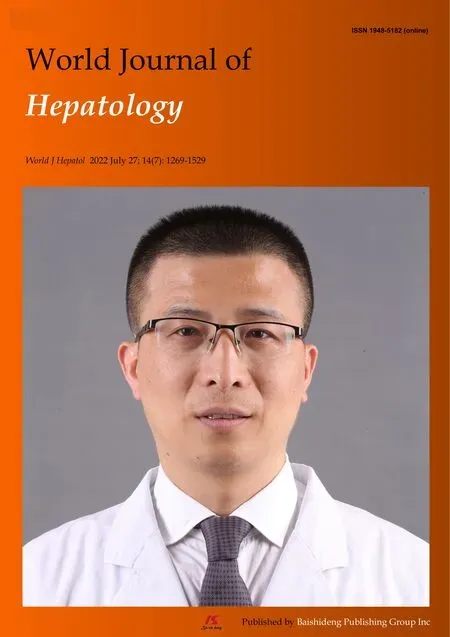Retraction Note: Screening and identification of bioactive compounds from citrus against non-structural protein 3 protease of hepatitis C virus genotype 3a by fluorescence resonance energy transfer assay and mass spectrometry
Mahim Khan, Waqar Rauf, Fazal-E- Habib, Moazur Rahman, Mazhar Iqbal
Mahim Khan, Waqar Rauf, Fazal-E- Habib, Moazur Rahman, Mazhar lqbal, Health Biotechnology Division, National Institute for Biotechnology and Genetic Engineering, Faisalabad 38000, Punjab, Pakistan
Abstract Retraction note: Khan M, Rauf W, Habib F, Rahman M, Iqbal M. Screening and identification of bioactive compounds from citrus against non-structural protein 3 protease of hepatitis C virus genotype 3a by fluorescence resonance energy transfer assay and mass spectrometry. World J Hepatol 2020; 12(11): 976-992 PMID: 33312423 DOI: 10.4254/wjh.v12.i11.976. The online version of the original article can be found at https://www.wjgnet.com/1948-5182/full/v12/i11/976.htm.
Key Words: Non-structural protein 3; Hepatitis C virus; Genotype 3a; Fluorescence resonance energy transfer
TO THE EDlTOR
In this manuscript, actually our study focus was to develop fluorescence resonance energy transfer (FRET) assay through expression of non-structural protein 3/4a (NS3/4A) protease of HCV genotype 3a, followed by the evaluation of extract and targeted pure natural products. However, we mistakenly used the expression vector that contains co-factor NS4A from genotype 1a. But whole story was built and described on the use of NS4A sequence/expression vector from the genotype 3a. The amino acid sequences of NS4A of the genotype 1a (KKGSVVIVGRIVLSGK) is significantly different from the genotype 3a (KKGCVVIVGHIELGK) that lead to the variation in the activity of NS3/4A protease[1].
We checked NS3/4A activity with co-factors from both genotypes (1a and 3a) and found a clear variation in the proteolytic activity of NS3 protease when fused to its respective co-factor NS4A. As mentioned earlier, in the published manuscript, by mistake we supplemented the full-length NS3 and NS4A-fused NS3 protease with a peptide derived from the NS4A of a genotype 1a virus that led to wrong interpretation and conclusion. Now we found that NS4A of a genotype 3a virus is really compatible with NS3 protease (3a) and exhibited much higher protease activity than the NS4A of a genotype 1a virus. Subsequently, this led to difference in the inhibitory concentration values of inhibitors (extracts and natural products) screened through the FRET assay. This significant variation in the activity assay has altered the downstream inhibitory activities of extracts and natural products. Regrettably, this situation has forced us to retract our paper[2] to conduct more experimentation and make the major correction in data, before we can consider its rewriting and publication.
FOOTNOTES
Author contributions:Khan M wrote this retraction note.
Conflict-of-interest statement:The authors declare that they have no conflicts of interest.
Open-Access:This article is an open-access article that was selected by an in-house editor and fully peer-reviewed by external reviewers. It is distributed in accordance with the Creative Commons Attribution NonCommercial (CC BYNC 4.0) license, which permits others to distribute, remix, adapt, build upon this work non-commercially, and license their derivative works on different terms, provided the original work is properly cited and the use is noncommercial. See: https://creativecommons.org/Licenses/by-nc/4.0/
Country/Territory of origin:Pakistan
ORClD number:Mahim Khan 0000-0003-3641-083X; Waqar Rauf 0000-0003-2853-3493; Fazal-E- Habib 0000-0002-4587-0312; Moazur Rahman 0000-0003-2892-1250; Mazhar Iqbal 0000-0002-8675-1125.
Corresponding Author′s Membership in Professional Societies:The American Chemical Society, 30176895.
S-Editor:Xing YX
L-Editor:A
P-Editor:Xing YX
 World Journal of Hepatology2022年7期
World Journal of Hepatology2022年7期
- World Journal of Hepatology的其它文章
- Challenge of managing hepatitis B virus and hepatitis C virus infections in resource-limited settings
- Gut microbiota contribution to hepatocellular carcinoma manifestation in non-alcoholic steatohepatitis
- “Starry liver” - Von Meyenburg complex clinical case presentation and differential diagnosis discussion: A case report
- Hepatitis B virus markers in hepatitis B surface antigen negative patients with pancreatic cancer: Two case reports
- Volumetric assessment of hepatic grafts using a light detection and ranging system for 3D scanning: Preliminary data
- Hepatitis C virus burden: Treating and educating people without prejudice
